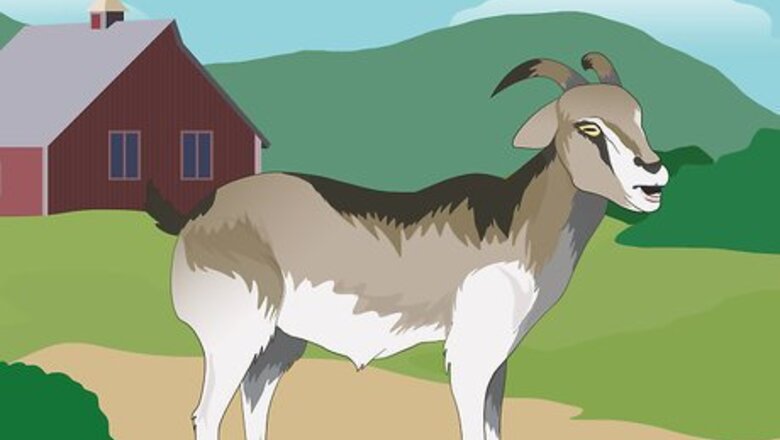
views
Caring for a Quality Goat
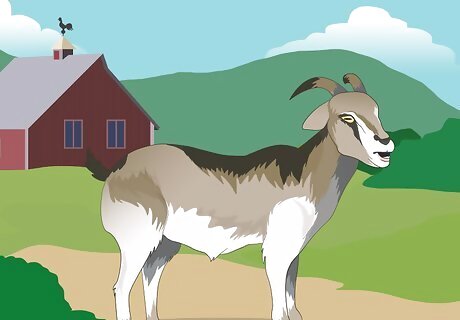
Select a quality goat. There are certain things you should look for when selecting a goat. You want a goat that lives up to show standards, as this can increase your chance of taking home a prize at the fair. Look for a goat with rounded shoulders and thick forelegs. The ribs should have deep twists as well as a soft feel. The goat's back should be strong. You should be able to see muscles throughout the back. Pay attention to the goat's head. A goat should have a straight jaw. A jaw that is overshot is known as a "parrot mouth" as it creates a beak-like appearance. An undershot jaw is known as a "monkey mouth."

Provide a safe environment. Once you select a goat, you need to maintain the proper environment. This will allow your goat to grow and thrive. Your goat should have a barn or shed to sleep in. Make sure it is at least 16 square feet. You should also have a fenced in area outdoors where your goat can roam and get exercise. Have the outdoor area as big as possible, as this will allow your goat to roam and play. Make sure your fence is at least 42 inches (110 cm) tall, as this will prevent your goat from escaping.
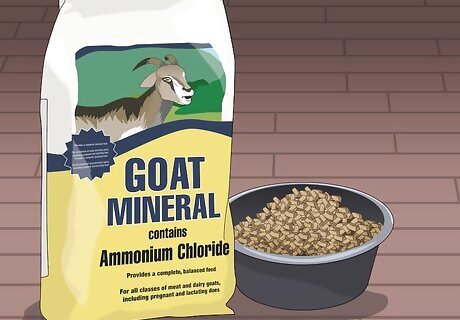
Feed your goat high quality food. You want a goat pellet that will make your goat grow big in preparation for the competition. You should go for a goat pellet comprised of 16% to 18% protein. This will help a young goat grow and build muscle. Feed your goat around 2 pounds of goat food a day. You will have to have some kind of trough or feeder in its barn. You should make sure the feed you choose contains ammonium chloride. This helps prevent issues with a goat's urinary tract.
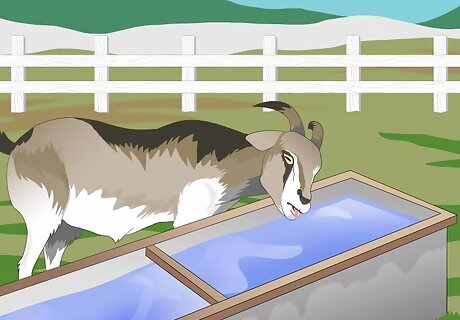
Give your goat plenty of water. This is essential to your goat's wellbeing. Water helps regulate the amount a goat eats. Goats that are dehydrated may overeat to compensate, resulting in obesity. Provide clean and fresh water on a daily basis. Always check the goat's water trough when checking in on your goat. If the water trough is dirty or empty, clean it out and add more water.

Provide proper vitamins and minerals. If you're feeding your goat a balanced diet, it should get most of the vitamins and minerals it needs. In addition to high quality pellets, give your goat fresh vegetables and grains to assure it is getting the right vitamins and minerals. Calcium, phosphorous, and salt are important to a goat's diet. Provide a salt lick for your goat, and feed your goat vegetables and grains. Vegetables have a lot of phosphorous, while grains are high in calcium. Vitamin A is the only vitamin your goat will not get naturally in its diet. Talk to a vet about adding vitamin A supplements to your goat's diet.
Preparing Your Goat for a Show
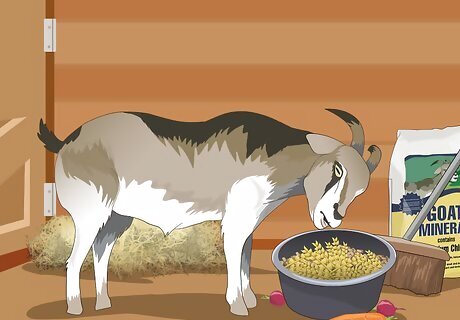
Adjust your goat's food as necessary. You want your goat to go into the show at a good weight. It may be necessary to feed your goat more or less in the weeks leading up to the show. Your goat should have some muscle definition in its back, legs, and flanks. You should also be able to feel your goat's ribs. Your goat should not have a visible belly. If your goat appears puffy and lacks muscle definition, cut back on feeding slightly. You can also remove some hay from your goat's barn and pen to prevent snacking.
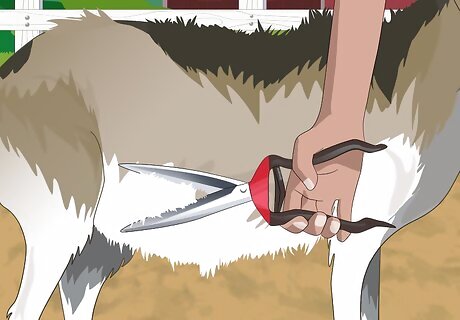
Cut your goat's hair. A goat's hair should be neat and trimmed prior to a show. In the days leading up to the show, make sure to give your goat a good trim. Use a pair of shears to trim uneven hair on your goat. Target hair around the hooves, on the belly, in the ears, and at the bottom of the tail. You should also trim any uneven hairs on the goat's chin. Check the expectations of the show you're attending. It may be preferable to shave your goat. If you choose to shave your goat, do it at least two weeks before the show. Use a blade that trims hair between 1/2 and 1/4 inch long. The hair on the hocks and knees should not be shaved. Your goat may be nervous for the clipping or shaving process. It's a good idea to have a friend or family member hold the goat still while you work.
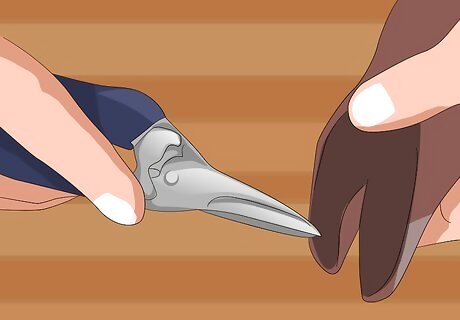
Trim your goat's hooves. Your goat will look more presentable at the show with neatly trimmed hooves. Use a good pair of hoof shears to trim your goat's hooves. Prior to cleaning, you should also use a hoof pick to clean manure and dirt out of your goat's hooves. You should also scrub the sides of the hooves with a toothbrush to get them clean. A goat's hoof has a hard outer shell protecting the soft white portion inside. Start by trimming around the outer portion. Then, move on to the white portion. The goal is to trim down your goat's hooves until they're level on the ground. Keep trimming until the white portion turns to pink. Make sure the goat's heel and toe are on the same level.
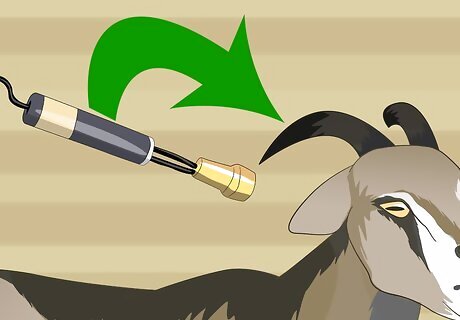
De-horn your goat, if necessary, should be done when kids are 4 to 10 days old. De-horning is required in some competitions. Check regulations at your show. If you need to de-horn your goat, do so prior to the show. You will need a de-horning iron, which you can get at a livestock store. It will need to be plugged in to warm up for about 10 minutes. Trim the area around the goat's horns with a pair of shears. Then, put your goat in a holding box. This is a box that restricts a goat's movements, allowing you to de-horn safely. You should also have a helper hold the goat still while you work. Place the de-horner around the budding horn. Rotate the de-horner counter clockwise for 3 to 4 seconds. A copper ring should form at the base of the bud. Use a sharp knife to cut off the bud at the copper ring. It should come off fairly easily. Repeat with the other horn.
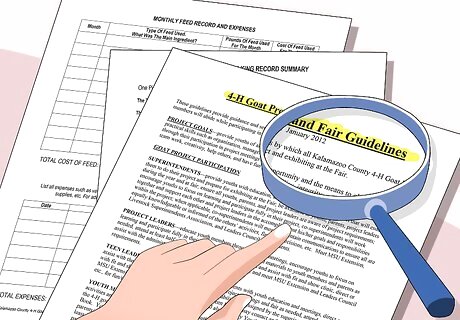
Review the rules of your specific show. Different shows have different rules. You want to see what is required in your show. You may have to walk the goat and show the goat in a specific manner. Ask your 4-H leader to provide you with guidelines and read them closely before the show. There will also probably be guidelines in terms of what kind of paperwork you need for the show. You want to make sure you have all your materials assembled before it's time to show your goat.
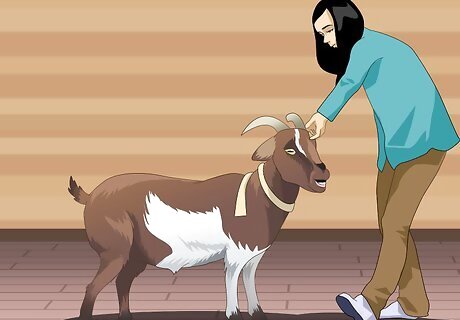
Practice in a barn. Once you know what to expect, practice. Nothing will prepare your goat better than regular practice prior to the show. Practice leading your goat around using a harness and lead rope. If you need to move your goat for the judge in any specific way, such as making the goat walk backwards, practice prior to the show. Practice every night leading up to the show. You and your goat should have the expected routine down before the show begins.
Showing Your Goat

Get scrapie tag and official ID with the Board of Animal Health. These are required for 4-H shows. The scrapie is a tag that goes on your goat's ear, verifying your ownership. An ID from your state's Board of Animal Health assures that your goat is healthy. Regulations vary in terms of how to get the scrapie tag. Ask your 4-H leader about regulations in your state. You should also be able to find this information somewhere on your state government's website. Usually, the ID from the Board of Animal Health is some kind of certificate. Your goat may also be given some kind of animal identification number. As with the scrapie tag, how to get this paperwork varies by state. Check with your 4-H leader or check your government's website.
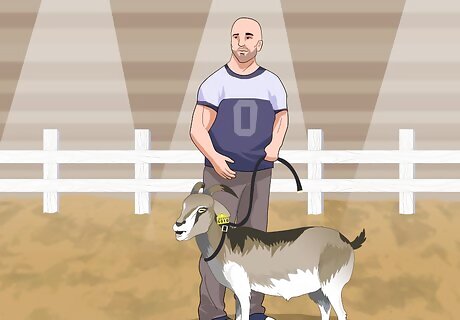
Present your goat. At the show you will be asked to present your goat to judges. Keep calm and follow your judge's instructions. How exactly you present your goat varies state by state. Make sure you give equal attention to the goat and the judge. Shift your gaze from your goat to the judge throughout the presentation. Make sure not to do anything to draw attention away from the goat. Avoid fidgeting or talking too much. You should only talk when the judge asks you a question.
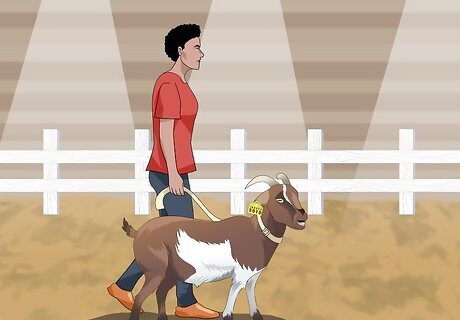
Move your goat when asked. The judge will ask you at some point to walk with your goat. Lead your goat around the arena with the lead rope as the judge watches. Walk slowly. The proper speed for your goat is one step at a time. If you walk with other goats, leave an adequate amount of space. There should be enough space that one goat could fit between your goat and the goat ahead of you.
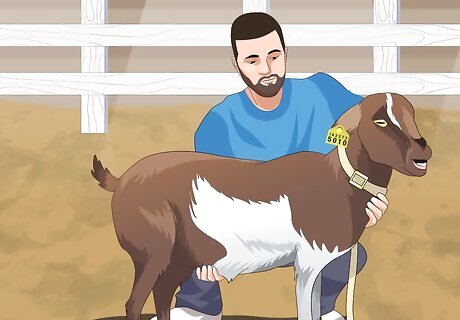
Shift your goat's position when asked. The judge may request that you move to the right or backwards slightly. This is to help the judge get a good view of the goat. Follow the judge's instructions carefully to assure you get a high score. If you need to switch sides, always walk in front of the goat rather than behind the goat.












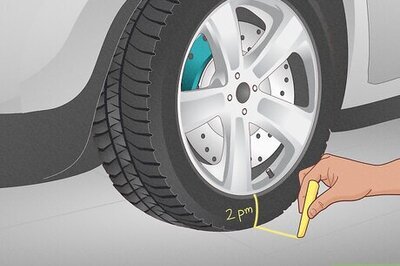





Comments
0 comment